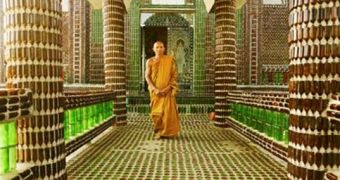Whoever said that a bottle gets you closer to Nirvana was definitely wrong. Over a million of them might do the trick, though. At least, that's what monks from a temple in Thailand think. The temple's real name is Wat Pa Maha Chedi Kaew, but it is better known to locals and visitors from abroad by a more accurate one – Wat Lan Kuad, Thai for the “Temple of Million Bottles.”
Currently, as part of a new approach to recycling, almost everything in the temple is made of glass bottles, and, indeed, there's more than one million of them. They're integrated into floors, walls, shelters, the pagoda, the ceremony hall, the crematorium, the pool, the fences, and even the toilets, either as a design feature or a as supporting one. Bottle caps and tops were creatively used for interesting mosaic mural decorations. Apparently, people like what they see when they visit this place of recollection, since they continue to help the monks by donating even more bottles.
The Wat Lan Kuad temple is situated in the Thailand province of Sisaket, about 370 miles (almost 600 kilometers) northeast of the capital city of Bangkok. The whole idea of using discarded bottles appeared 24 years ago, in 1984, when the monks of that time first used the recipients to beautify their shelters. This may appear rather strange, since it is known that the consumption of alcohol is strictly forbidden by the commandments of Buddhist religion.
The constant donation of bottles from visitors helped the monks raise the unprecedented, environment-friendly edifice as it stands today. Besides the fact that glass is a reliable building material that also looks interesting, it allows the presence of natural light, doesn't fade in time, and is much easier to maintain than other types of construction materials. Currently, monks are still accepting donations of bottles. According to Abbot San Kataboonyo's declaration to Reuters, “The more bottles we get, the more buildings we make.”

 14 DAY TRIAL //
14 DAY TRIAL //